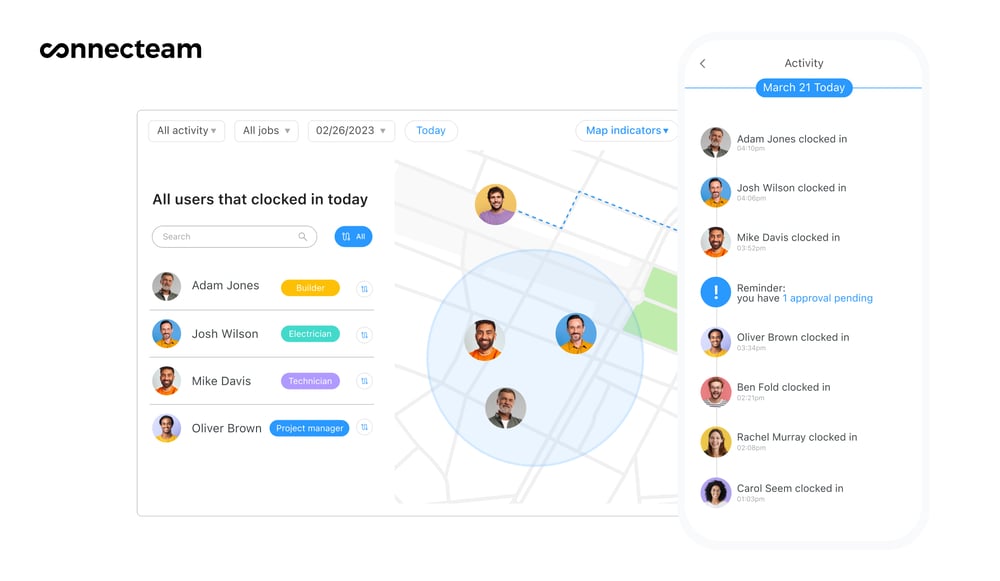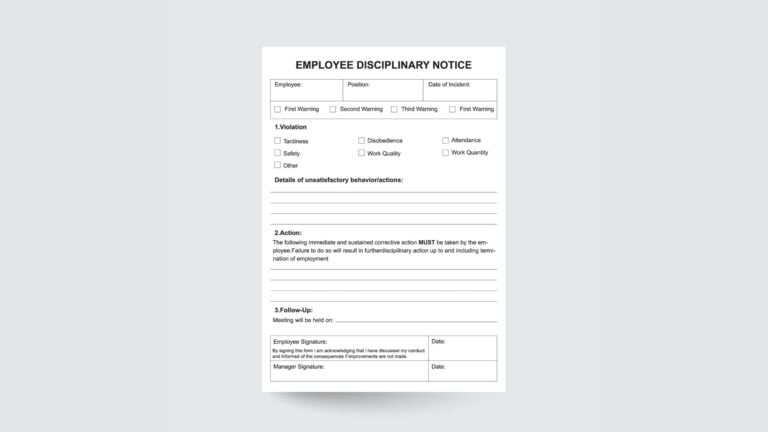Dealing with employees who leave work early without permission requires a mix of empathy and enforcement. Here are 5 expert tips for handling this scenario.
Employees leaving work early without permission can disrupt workflow, impact team members, and worse. But dealing with these situations isn’t easy—as you must consider your company policies and your employees’ needs.
So how do you handle unpermitted departures smoothly? Let’s dive into some practical tips.
Key Takeaways
- Some of the best ways to deal with an employee who leaves work early without permission are to give them the benefit of the doubt, clarify your attendance policies, and implement a formal approach.
- You should also consider if your work culture is contributing to the problem, plus find ways to incentivize employees to stay through the workday.
- Finally, time tracking software with GPS or geofencing capabilities can deter employees from leaving early.
Give Them the Benefit of the Doubt
From family emergencies to feeling sick to simply mixing up their work schedule, there are all sorts of possible explanations for why your employee has left early.
If this is the first time you’ve seen such behavior, avoid taking a confrontational approach and risking a breakdown of trust. Showing empathy and support is key. For example, you might say:
“I noticed you headed home early yesterday. That’s out of character for you—has something happened?”
If they have a valid excuse, approach the conversation with compassion and an open mind to clear up any misunderstandings. If possible, find ways to prevent them from leaving early again—unless they have a good excuse for needing to leave work early again (for instance, a parent might need to leave work early for a period of time because their after-school childcare plans fell through).
Your response might change if your employee doesn’t have a valid excuse. For instance, if they respond with, “I just felt like it,” set some clear boundaries. Gently explain the importance of communicating about their wish to leave early and sticking to work schedules. While compassion is crucial, you must balance it with your workplace’s standards and policies.
If the employee is a repeat offender, shift your approach. Start with empathy, but quickly outline the consequences and the changes the employee must make. Keep a record of these instances so you’re prepared to follow through with formal actions if needed.
Pro Tip
It’s your duty to ensure your employees are safe. If someone isn’t at work when they should be, check to see if they’re okay. If they’re not answering their phone, reach out to their emergency contacts.
Clarify Your Attendance Policies
Unclear and hard-to-access policies could also be contributing to employees leaving early.
An employee who was new to the workplace said: “I’ve noticed that I’m usually the last one in and the first to leave. I know that I’m technically meeting my hour requirements but I don’t know what the unspoken rules are on when I should actually be here and leave to give a good perception as a hardworking employee.”
Avoid being vague and ensure clear protocols for early departures are outlined explicitly in writing.
Your policy should outline:
- Valid reasons for leaving early, such as emergencies, appointments, or caretaking responsibilities.
- The procedure for requesting to leave early, including who to notify and how, as well as how much notice is required.
- Your criteria for approval, such as your business needs or the frequency of the employee’s requests.
- Options for making up time and recording adjusted hours.
- Consequences of unauthorized leave—for example, a verbal warning followed by a written warning, and so on.
- The manager’s role in approving requests.
Pro Tip
Hold a deep-dive session on your attendance policies using real-world scenarios to bring them to life and illustrate acceptable and unacceptable behavior.
Make sure this information is accessible for new people, perhaps in an employee handbook or company knowledge base.
Did You Know?
With Connecteam, you can keep policies easily accessible to employees in your company knowledge base. Employees can access these from their mobile devices.
Implement a Formal Approach
When employees leave work early without permission and informal approaches aren’t effective, you must take things to the next stage. Here’s how:
Review the evidence
Ensure detailed records of the incidents are kept, including dates, times, and any reasons for leaving given by the employee. This documentation is crucial for understanding the pattern and context of the behavior.
Craft a fair plan of action
Develop a response that aligns with company policies and is fair to the employee. For example, if an employee repeatedly leaves early without notice, the plan might include:
- An initial conversation between the employee, manager, and HR to address the issue and clarify expectations.
- Support and accommodations. Personal challenges such as mental health struggles, ongoing illnesses, or urgent family matters may require flexibility and compassion. Could you offer them a mental health day to recharge, time off for medical appointments, or a period of sick leave to recover from an illness, for example?
Did You Know?
You might be legally required to give some employees reasonable accommodations for challenges they face—or at least to consider accommodation requests. These accommodations might include changes to work schedules, including early departures.
- Ongoing check-ins with the employee to ensure they’re on track and any accommodations are working.
- A written warning if the employee has had every opportunity to improve but the behavior continues.
- Disciplinary action for further infractions.
This step-by-step approach ensures the employee feels supported and heard but understands the seriousness and consequences of their actions.
Pro Tip
If the job allows it, consider accommodating all workers with more flexible schedules—or at least considering their schedule change requests. For instance, some workers might need or prefer to start and end the workday earlier. Or, some workers might have difficulty making it through a long workday and want to finish their work at home.
Issue warnings appropriately
When issuing warnings:
- Clearly outline the reason for the warning and ensure it’s aligned with your policies. If your policies don’t say anything about leaving work early without permission, you might not have the grounds to issue a warning.
- Ensure your approach is consistent with how you’ve addressed similar behavioral issues in the past. For example, say another employee wasn’t given a warning after leaving work early without permission multiple times. It would be unfair to give a warning to a different employee for the same issue.
- Base your warning on solid documented evidence. This means you should have a system in place for tracking early departures. For example, time and attendance tracking software keeps a record of tardiness, earlier departures, and absences.
- Follow procedures laid out in your employee handbook. For example, if your handbook gives employees the right to appeal, they should have the opportunity to do this.
- Adhere to employment law. For instance, say a pregnant worker requires occasional early departures to manage their pregnancy as a reasonable accommodation. Issuing a standard warning without considering protections for pregnant workers could constitute discrimination.
Sometimes, the formality of a warning or disciplinary action is what an employee needs to recognize the seriousness of their behavior and to start making changes.
Can you fire an employee for leaving work without permission?
Leaving work without permission is usually seen as misconduct and could lead to dismissal in serious cases. But there are legal complexities.
For example, if the early departure is due to protected reasons like illness covered under the Family and Medical Leave Act (FMLA) or pregnancy-related conditions protected by the Pregnancy Discrimination Act (PDA), firing the employee could have legal consequences.
In addition, terms of collective bargaining agreements and your employment contract can further complicate this. These terms might set out specific procedures and reasons for disciplining and terminating the employee, and you must follow these.
It’s best to ask for legal advice before deciding to terminate.
Consider Your Workplace Culture
Consider whether your workplace culture could be contributing to attendance issues and how you can address this. Various employees leaving work early without permission might be a symptom of deeper cultural issues that warrant attention.
Did You Know?
With Connecteam’s attendance reports, you can analyze trends over time to discover if there’s a pattern of unpermitted early departures.
Cultural elements that might be contributing to employees leaving early without permission
Overworking leading to burnout
In many workplaces, overworking is seen as a badge of honor, but it often leads to burnout and a desire for employees to “reclaim their time.”
One employee wrote: “10-14 hours of active work time daily has been the norm for the past few months. It’s severely impacted my personal obligations. Would I be in the wrong to reclaim some of my time and leave a few hours early?”
Consider whether you’re setting reasonable expectations on workload or if resentment around long working hours could be contributing to early departures.
Problems with leadership
If leaders leave early without clear communication, it signals to others that this is acceptable behavior. Likewise, when discipline isn’t consistently enforced and “getting away with things” is the accepted norm, employees might assume there aren’t repercussions for leaving early.
One employee wrote: “Every day my boss will leave about 30 minutes before the office closes up. From that point, the rest of us just sort of trickle out of the office one by one.”
A toxic workplace environment
Something might be making your employees feel disempowered or marginalized, causing them to withdraw and leave work early to escape a negative environment. For instance, a pattern of people leaving early when a particular manager is on shift might indicate the manager is causing employees to leave.
Disengagement
Disengagement can stem from various factors, including a lack of stimulating work, unclear purpose, or a sense of exclusion from decision-making processes. Employees who feel disconnected from broader goals may not see the value in seeking permission before leaving.
Pro Tip
Consider if employees leaving early is really a bad thing. For example, say you have a results-oriented culture where the focus is on outcomes rather than hours logged. If employees have completed their tasks for the day and are performing to a good standard, consider giving them the freedom to leave as they please.
How to change your work culture to prevent employees from leaving early
If you suspect your workplace culture might be driving problematic attendance issues, here are steps you can take to foster a more positive environment:
- Promote open communication: Create open dialogue between employees and management about workload, expectations, and challenges. You might use all-hands meetings, for example.
- Address burnout and workload: Evaluate workload distribution and ensure employees have the resources and support needed to perform their tasks effectively without undue stress. If employees are overworked, consider redistributing work or lightening the workload.
- Address disengagement and workload. If employees don’t have enough work or aren’t stimulated by their work, encourage involvement in meaningful projects and inclusion in meaningful business decisions.
- Cultivate accountability: Ensure any behavioral issues—attendance related or otherwise—are addressed early and consequences are carried out consistently. This isn’t about punishment but rather fostering a sense of responsibility and mutual respect.
- Empower employees: Equip employees with the skills and resources to recognize and address problematic behaviors in the workplace. Provide avenues for them to voice their concerns about their leaders, for example.
Pro Tip
Use the Connecteam survey app to collect feedback on your workplace culture. You can even collect anonymous feedback from employees so they feel safe voicing their concerns.
Give Employees a Reason To Stay
There are plenty of creative incentives to prevent your employees from wanting to sneak out early. Here’s a few innovative ideas to encourage them to stay through the workday.
Switch-off afternoons
An overwhelming number of calls, emails, and interruptions might be causing your team members to give up early. If feasible, ask your whole company to switch off notifications for a window of time during certain afternoons. This allows everyone space to focus on their tasks without distractions.
Well-being hours
These offer employees a couple hours a month to refresh, recharge, and focus on their well-being. These are paid hours employees can use any time throughout the month and don’t have to make up. They might use these to handle personal issues that would otherwise cause them to leave work early.
Themed lunches
Maybe it’s the 3:00 pm boredom kicking in that’s causing employees to leave early. Incentivize them to stay by holding free lunches with fun themes—for example, Taco Tuesday or Waffle Wednesday. Hopefully, the element of surprise and the chance to socialize will boost their motivation into the afternoon.
Use Time Tracking Software as a Deterrent
Modern time tracking software includes capabilities that can potentially deter workers from leaving early. For example, some tracking software enables your workers to clock in and out right from their mobile devices and includes GPS and geofencing capabilities.

With GPS, you can track workers’ locations as you’re tracking their work hours to verify they’re where they should be. Geofencing takes this a step further. You can create virtual boundaries around physical worksites and even prevent workers from tracking their time outside these boundaries.
This way, if workers leave early without permission, their time won’t be tracked. This might deter some workers from leaving early.
Example tips to share with employees who need to leave work early
- Know your policies: Familiarize yourself with attendance policies and follow all the necessary steps to take an early departure. Ask your manager or HR team if you need more clarity on these.
- Give notice: As soon as you’re aware that you need to leave early, contact your manager. The sooner you communicate, the easier it will be to get approval.
- Share your reasons: Be honest with your employer about your excuse for leaving work early. Providing a valid reason for your departure will show the request is legitimate. You can maintain privacy by providing a general reason rather than a specific one.
- Make up the time: Offer to start early the next day or add a couple of hours on at the end of the week.
The Bottom Line on Dealing With Employees Leaving Early Without Permission
Managing employees who leave work early without permission requires empathy and clear expectations. Start by listening to their reasons and offering support where possible. Communicate attendance policies clearly and implement a structured response. Consider if your work culture might be contributing to problems.
To incentivize workers to stay through the day, consider incentives like themed lunches, well-being hours, or focused “switch-off” afternoons.
Finally, consider using time tracking software to deter employees from leaving early. Connecteam is an all-in-one time tracking solution with various other features for engaging and managing employees.




